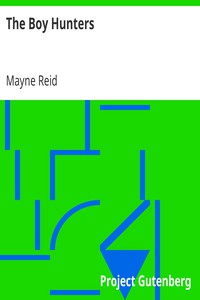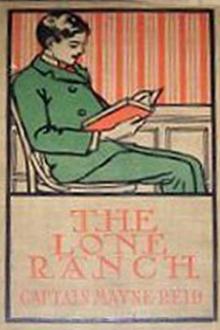The Boy Hunters, Mayne Reid [best love novels of all time .TXT] 📗

- Author: Mayne Reid
Book online «The Boy Hunters, Mayne Reid [best love novels of all time .TXT] 📗». Author Mayne Reid
As they watched his motions, their eyes were caught by a shining object that moved along the wrinkled bark of the liana. As the vine was nearly a foot in diameter, and of a deep ferruginous colour, this object was the more apparent against its dark ground, for it was a creature of brilliant hues. It was an animal of the lizard species; and if any lizard could be considered beautiful, this one might have been so called. But the hideous, half-human form of these animals, their piercing looks, their stealthy and predatory habits, and, above all, the knowledge that the bite of several of their species is poisonous, combine to render them objects that excite disgust and awe, rather than admiration.
This one, as we have already said, was of the most brilliant colour. The whole of its upper surface was a golden green, vivid as the hues of an emerald; while its body underneath was greenish-white. But this part, as it lay along the liana, was not seen; and a pure, uniform green was the apparent colour of the whole animal. There was one conspicuous exception—the throat. This was swollen out, as though by inflation, exhibiting a surface of the brightest scarlet, that appeared in the sun as if painted with vermilion. The eyes of the animal shone like flame—for the irides were, in fact, the colour of burnished gold, with small pupils, sparkling like diamonds, in their midst. Its arms and limbs were of the same colour as the body; and its branching feet exhibited the peculiarity of having small knots or tubercules at the ends of the toes. These tubercules, together with the loose dewlap of the throat, told the genus to which the animal belonged,—an anolius of the family Iguanidae, and the only species of the anolius found in the territory of the United States.
These facts were communicated by Lucien to his brothers in a whisper, while they were observing the creature on the liana. Basil and François had often seen the species before, and were familiar with it under the names of “green lizard” and “chameleon,”—both of which names are applied to it in common phraseology. The animal was not over six inches in length; and its long coffin-shaped head, and slender, whip-like tail, were at least two-thirds of this extent. When first noticed, it was passing up the liana, for the latter slanted upwards between the trees. It did not see the boys; or, at all events, did not regard their presence—for the chameleon is a bold little animal, and is not afraid of man. Up to this time it had not seen the tarantula either. As it was passing onward, its eyes fell upon the latter as he climbed up his silken ladder. All at once the lizard stopped, and put itself into a crouching attitude. Its colour suddenly changed. The vermilion throat became white, and then ashy pale; and the bright green of its body faded into dark brown or rust colour, until it was difficult to distinguish the animal from the bark of the liana! Had the eyes of the spectators not been already fixed upon it, they might have supposed that it had disappeared altogether. After crouching for a few seconds, it seemed to have formed its plan of attack—for it was evident that it meant to attack the spider—such, with flies and other insects, being its natural food and prey. It passed to the opposite side of the liana, and then proceeded upward, making for the nest of the tarantula. It reached this point by a single run, although its back was downward as it crawled. This it could easily do by means of the tubercules upon its toes—which enable lizards of the genus anolius to walk upon perpendicular walls, up glass windows, or along the smoothest ceilings.
For some moments it lay quiet in a crouching attitude, waiting the approach of the spider, that, busied with his own affairs, did not dream of a lurking foe so near him. The tarantula was, no doubt, in high spirits at the moment, exulting at the prospect of the banquet of blood he should have, when he had carried the ruby-throat to his dark, silken cave. But he was destined never to reach that cave. When he had got within a few inches of its entrance, the chameleon sprang out from the limb, seized the spider in his wide jaws, and all three—lizard, spider, and bird—came to the ground together. The bird was let go in the fall, and became separated from the others. Between these there was a short struggle over the grass—for the tarantula fought fiercely; but he was no match for his antagonist; who, in a few moments, had ground off his legs with his powerful jaws, and left him a helpless and motionless trunk. The chameleon now seized his victim by the head, sunk his sharp, conical teeth into its skull, and thus killed it outright.
What appeared singular to all was, that the moment the lizard had first sprung upon his prey his bright colours returned like a flash, and he again appeared with his green back and red throat, if possible more brilliant than ever.
He now commenced dragging the body of the spider over the grass, evidently making for some decayed logs, half covered with vines and briars, that formed a heap near the spot. Here, no doubt was his retreat.
This time François did not attempt to interfere. He had no desire to do so. He looked upon the death of the tarantula as a just punishment; moreover, the chameleon, from its fine colours, its sportive habits, and its harmlessness—so far as man is concerned—is a general favourite with all; and it was so with François. In fact, François, as well as his brothers, who had often watched this little creature gambolling among the leaves, and feeding upon flies and other small insects, had never seen it exhibit so much ferocity before. Notwithstanding this, they all applauded it for killing the hideous tarantula; and so far as they were concerned, it might have carried the body to its hole without being molested. It was destined, however, to meet with interruption from another quarter. François, whose quick eyes were wandering about, suddenly exclaimed,—
“Look—brothers, look! A scorpion-lizard!”
Basil and Lucien cast their eyes where François pointed—up to the trunk of a tree that rose over the spot where the chameleon was crawling. About twenty feet from the ground was a dark, round hole, evidently the former nest of the red-bellied woodpecker (Picus Carolinus). The birds, however, who made that nest had deserted it; for it was now occupied by a creature of a far different kind—a scorpion-lizard—whose red head and brown shoulders at the moment protruded from the hole.
All who have travelled the great American forests are familiar with such a sight—for this animal may be often observed in similar situations. A more disagreeable sight is rarely met with. The scorpion-lizard, with his red head and olive-brown body, is a hideous-looking reptile at best; but when thus peering from his gloomy tree-cave, moving his pointed snout from side to side, his dark eyes glancing all the while with a fierce, malignant expression, it is difficult to conceive a more vicious-looking creature.
His head was in motion when François spake—for it was this that had caught the eye of the boy. It was moving from side to side, protruded out from the hole, the snout pointing downwards. The animal was watching the ground below, and evidently preparing to issue forth, and come down. The chameleon, rustling over the dead leaves, had attracted his attention.
As quick as lightning his whole body appeared upon the tree, and lay flat along the bark, head downwards. Here he halted for a moment; then, raising his shoulders, he ran nimbly down the trunk, and rushing outwards, sprang upon the chameleon. The latter, thus suddenly attacked, dropped the spider; and at first showed an intention of retreating. Had he done so the scorpion would have followed him no farther—as its only object in attacking him was to rob him of his prey. The chameleon, however, is a courageous little animal; and seeing that his assailant was not much bigger than himself—for the animal in question was one of the smallest of the skink family—he turned again and showed fight. His throat swelled to its largest extent, and grew brighter than ever.
Both now stood facing each other, and about twelve inches apart, in threatening attitudes. Their eyes sparkled; their forked tongues shot forth, glittering in the sun; and their heads at intervals rose and fell, in a manoeuvring manner, like a pair of pugilists “coming to the scratch!”
After a short while they sprang at each other open-jawed; wriggled over the ground a moment—their tails flying in the air—then separated, and again assumed their defiant attitudes, manoeuvring as before. In this manner they met and parted several times, neither seeming to have gained much advantage.
The weakest part of the green lizard lies in his tail. So tender is this appendage that the slightest blow of a small switch will separate it from the body. The skink seemed to be aware of this fact, as he several times endeavoured to get around his antagonist, or, in military phraseology, to “turn” him. It was evidently his intention to attack the tail. This the chameleon dreaded; and was equally desirous not to be “outflanked.” In whatever way the skink manoeuvred, his antagonist met him with his scarlet front.
For several minutes the battle raged—these little creatures exhibiting as much fury and fierceness as if they had been a pair of great crocodiles. The chameleon at length began to show symptoms of giving out. The throat grew paler—the green became less vivid—and it was evident that he was getting the worst of it. The scorpion now made a rush, and threw the other upon his back. Before the chameleon could recover himself, his antagonist seized his tail, and bit it off close to the body. The poor little fellow, feeling that he had lost more than half his length, scuttled away, and hid himself among the logs.
It was well for him, as it proved afterwards, that he got off, even thus mutilated; and it would have been better for the skink had he remained in his hole. The battle between the two had carried them some distance from the spot where it first commenced, and under the leafy, spreading branches of a mulberry-tree. While the fight was raging, a slight movement in the leaves above had attracted the attention of the boys. The next moment a red object was thrust downward, until a foot or so of it appeared hanging clear of the branches. It was about the thickness of a walking-cane; but the glistening scales and the elegant curving form told that this singular object was a serpent.
It did not remain stationary. It was slowly and gradually letting itself down—for more of its body was every moment becoming visible, until a full yard of it hung out from the leaves. The remainder was hidden by the thick foliage where its tail no doubt was coiled around a branch. That part of the body that was seen was of a uniform blood-red colour, though the belly or under side was much the lightest.
“Voilà!” muttered François, “what a red snake! I never saw such before.”
“Nor I either,” added Basil.
“Nor I,” said Lucien, “but I have heard of it. I easily recognise it from the description. It is the ‘red snake’ of the Rocky Mountains (Coluber testacea).”
“Oh,” said Basil, “I have heard trappers speak of it.”
“Yes,” added Lucien. “It is a rare species, and only found in the Far West. See! the scorpion has whipped. The chameleon is running off, and, as I live, without its tail!”
The skink at this moment perceived the long, red body of the serpent dangling above him; and





Comments (0)